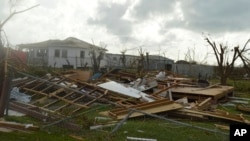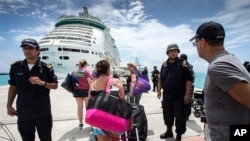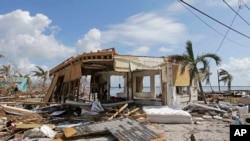Navigating the aftermath of Hurricane Irma on Caribbean tourism can be daunting. SIXT.VN offers expert travel advice to help you plan your trip to Vietnam, ensuring a seamless and enriching experience. Discover reliable travel services and explore hidden gems with our guidance.
1. What Was the Immediate Impact of Hurricane Irma on Caribbean Tourism?
The immediate aftermath of Hurricane Irma on Caribbean tourism was devastating. The storm, one of the most powerful ever recorded in the Atlantic, directly impacted several islands that heavily rely on tourism for their economic survival. According to the Caribbean Tourism Organization, the region experienced a record 29 million tourist arrivals in 2016, generating nearly $36 billion. However, Irma caused widespread damage to critical infrastructure, including airports, roads, hotels, and resorts, crippling the tourism sector.
1.1 Infrastructure Damage and Closures
Airports and seaports, vital for tourist access, were severely damaged or forced to close. For example, the Princess Juliana International Airport on St. Maarten, famous for its low-flying aircraft landings, suffered extensive damage, temporarily halting commercial flights. Hotels and resorts faced structural damage, power outages, and water shortages, making them uninhabitable and leading to widespread closures.
1.2 Disrupted Tourist Season
Hurricane Irma struck just before the start of the high tourist season, which typically runs from December to April. The destruction caused by the storm led to mass cancellations of bookings, resulting in significant financial losses for the region. The uncertainty surrounding the recovery timeline further deterred potential visitors, compounding the economic impact.
1.3 Humanitarian Crisis and Evacuations
The storm created a humanitarian crisis, with many residents and tourists requiring evacuation. Cruise lines and international aid organizations assisted in evacuating stranded tourists and delivering essential supplies. The focus shifted from tourism to providing basic necessities like food, water, and medical assistance, further sidelining the tourism industry in the immediate aftermath.
 Damage is left after Hurricane Irma hit Barbuda, Sept. 7, 2017.
Damage is left after Hurricane Irma hit Barbuda, Sept. 7, 2017.
2. Which Caribbean Islands Were Most Affected by Hurricane Irma’s Impact on Tourism?
Several Caribbean islands faced severe consequences due to Hurricane Irma. The most affected islands included Barbuda, St. Martin/St. Maarten, the British Virgin Islands, and the U.S. Virgin Islands. These destinations experienced significant damage, leading to a substantial decline in tourism.
2.1 Barbuda
Barbuda was one of the hardest-hit islands, with reports indicating that approximately 95% of its buildings were either destroyed or severely damaged. The devastation effectively shut down tourism, as the island’s infrastructure was rendered unusable. Rebuilding efforts were slow, and the island faced a long road to recovery.
2.2 St. Martin/St. Maarten
St. Martin, divided between French and Dutch territories, also suffered extensive damage. Witnesses reported that most buildings were flattened by Irma. The Princess Juliana International Airport, a critical gateway for tourists, sustained significant damage, further hindering recovery efforts. The island’s tourism sector experienced a massive setback, with many hotels and businesses forced to close indefinitely.
2.3 British Virgin Islands (BVI)
The British Virgin Islands, known for their luxury resorts and sailing destinations, experienced widespread destruction. Many resorts and marinas were severely damaged, and the territory’s infrastructure suffered significant blows. The impact on tourism was substantial, with the BVI facing a considerable decline in visitor arrivals.
2.4 U.S. Virgin Islands (USVI)
The U.S. Virgin Islands, including St. Thomas, St. Croix, and St. John, also sustained significant damage. Hotels, attractions, and infrastructure were severely affected, leading to a sharp decrease in tourism. The recovery process was complex, with the islands grappling with power outages, water shortages, and widespread debris.
3. How Did the Damage to Infrastructure Affect Tourist Arrivals and Revenue in the Caribbean?
The damage to infrastructure in the Caribbean had a profound impact on tourist arrivals and revenue. The destruction of airports, roads, and hotels directly hindered the region’s ability to accommodate and serve tourists, leading to a sharp decline in visitation and economic losses.
3.1 Decline in Tourist Arrivals
With airports and seaports severely damaged or closed, it became difficult for tourists to reach the affected islands. The resulting travel disruptions led to a significant drop in tourist arrivals. Many potential visitors canceled their trips, opting for alternative destinations perceived as safer and more accessible.
3.2 Loss of Revenue
The decline in tourist arrivals translated directly into a loss of revenue for the Caribbean economies. Tourism-related businesses, such as hotels, restaurants, tour operators, and transportation services, experienced a sharp decrease in income. The overall economic impact was substantial, with the region facing billions of dollars in lost revenue.
3.3 Impact on Employment
The tourism sector is a major employer in the Caribbean, providing jobs for a significant portion of the population. The disruption caused by Hurricane Irma led to widespread job losses in the tourism industry. Hotel staff, tour guides, restaurant workers, and other tourism-related professionals found themselves out of work, exacerbating the economic hardship faced by the region.
4. What Measures Were Taken to Mitigate the Impact on Tourism After Hurricane Irma?
In the wake of Hurricane Irma, various measures were implemented to mitigate the impact on tourism and facilitate recovery. These efforts involved governments, tourism organizations, and private sector stakeholders working together to restore infrastructure, promote the region, and support affected communities.
4.1 Infrastructure Restoration Efforts
One of the immediate priorities was to restore critical infrastructure, including airports, roads, and utilities. Governments and international aid organizations worked to clear debris, repair damaged facilities, and restore essential services. The goal was to make the islands accessible to tourists as quickly as possible.
4.2 Marketing and Promotion Campaigns
Tourism organizations launched marketing and promotion campaigns to reassure potential visitors that the Caribbean was open for business. These campaigns highlighted the islands that were less affected by the storm and showcased the ongoing recovery efforts. The aim was to rebuild confidence in the region and attract tourists back to the Caribbean.
4.3 Financial Assistance and Support
Financial assistance was provided to support businesses and communities affected by the hurricane. Governments and international organizations offered grants, loans, and other forms of financial aid to help businesses rebuild and resume operations. Support was also provided to individuals and families who had lost their homes and livelihoods.
 This photo provided by the Dutch Defense Ministry on Sept. 10, 2017, shows people walking toward a cruise ship anchored on St. Maarten, after the passage of Hurricane Irma.
This photo provided by the Dutch Defense Ministry on Sept. 10, 2017, shows people walking toward a cruise ship anchored on St. Maarten, after the passage of Hurricane Irma.
5. How Long Did It Take for Caribbean Tourism to Recover From Hurricane Irma?
The recovery timeline for Caribbean tourism following Hurricane Irma varied depending on the island and the extent of the damage. While some destinations were able to bounce back relatively quickly, others faced a longer and more challenging recovery process.
5.1 Varying Recovery Timelines
Islands that experienced less severe damage, such as Aruba, Bonaire, and Curacao, were able to resume tourism activities relatively quickly. These destinations actively promoted themselves as safe alternatives for tourists seeking a Caribbean getaway. In contrast, islands like Barbuda and St. Martin faced a more protracted recovery due to the extensive damage to infrastructure and facilities.
5.2 Gradual Reopening of Hotels and Resorts
The reopening of hotels and resorts played a crucial role in the recovery of Caribbean tourism. As damaged properties were repaired and renovated, they gradually reopened to guests. The pace of reopening varied depending on the extent of the damage and the availability of resources for reconstruction.
5.3 Return of Cruise Tourism
Cruise tourism is an important component of the Caribbean tourism sector. The return of cruise ships to the affected islands was a significant milestone in the recovery process. Cruise lines worked with local authorities to ensure that ports were safe and operational, allowing cruise passengers to visit and contribute to the local economy.
6. What Lessons Were Learned From Hurricane Irma Regarding Tourism Resilience in the Caribbean?
Hurricane Irma provided valuable lessons about the importance of tourism resilience in the Caribbean. The storm highlighted the need for better disaster preparedness, stronger building codes, and more diversified tourism offerings.
6.1 Enhanced Disaster Preparedness
The experience of Hurricane Irma underscored the importance of having robust disaster preparedness plans in place. This includes developing evacuation procedures, securing critical infrastructure, and training tourism staff to respond effectively to emergencies. Enhanced disaster preparedness can help minimize the impact of future storms on the tourism sector.
6.2 Stronger Building Codes
The widespread damage caused by Hurricane Irma highlighted the vulnerability of buildings to extreme weather events. Stricter building codes that require structures to withstand high winds and flooding are essential for protecting tourism infrastructure. Investing in resilient construction can help reduce the damage caused by future storms.
6.3 Diversification of Tourism Offerings
Relying heavily on a single type of tourism, such as all-inclusive resorts, can make a destination vulnerable to disruptions. Diversifying tourism offerings to include eco-tourism, cultural tourism, and adventure tourism can help create a more resilient tourism sector. This approach can attract a wider range of visitors and reduce the dependence on specific types of facilities.
6.4 Insurance Coverage
According to Moody’s Investors Service expert Gabriel Torres, companies with better disaster insurance will be able to rebuild more quickly. This highlights the need for businesses to have adequate insurance coverage to protect against losses caused by natural disasters. Insurance can provide the financial resources needed to rebuild and resume operations after a storm.
7. What Long-Term Strategies Can Help Caribbean Tourism Become More Sustainable and Resilient?
To ensure the long-term sustainability and resilience of Caribbean tourism, several strategies can be implemented. These include investing in climate change adaptation, promoting sustainable tourism practices, and strengthening regional cooperation.
7.1 Investment in Climate Change Adaptation
Climate change is increasing the frequency and intensity of extreme weather events, posing a growing threat to Caribbean tourism. Investing in climate change adaptation measures, such as coastal protection, improved drainage systems, and drought-resistant water supplies, can help reduce the vulnerability of the tourism sector to climate-related risks.
7.2 Promotion of Sustainable Tourism Practices
Sustainable tourism practices can help protect the environment, preserve cultural heritage, and benefit local communities. Encouraging eco-friendly accommodations, responsible tour operations, and community-based tourism initiatives can enhance the sustainability of the tourism sector. Promoting sustainable tourism can also attract environmentally conscious travelers who are willing to pay a premium for responsible tourism experiences.
7.3 Strengthening Regional Cooperation
Regional cooperation is essential for addressing the challenges facing Caribbean tourism. Working together to develop common standards for disaster preparedness, promote the region as a whole, and share best practices can enhance the resilience of the tourism sector. Regional cooperation can also help the Caribbean compete more effectively in the global tourism market.
 Debris surrounds a destroyed structure in the aftermath of Hurricane Irma, Wednesday, Sept. 13, 2017, in Big Pine Key, Fla. (AP Photo/Alan Diaz)
Debris surrounds a destroyed structure in the aftermath of Hurricane Irma, Wednesday, Sept. 13, 2017, in Big Pine Key, Fla. (AP Photo/Alan Diaz)
8. How Did Hurricane Irma Affect the Perception of the Caribbean as a Tourist Destination?
Hurricane Irma had a significant impact on the perception of the Caribbean as a tourist destination. The widespread destruction and disruption caused by the storm raised concerns about safety, reliability, and the overall quality of the tourism experience.
8.1 Concerns About Safety and Security
The storm created concerns about the safety and security of the Caribbean. Potential visitors worried about the risk of future storms, the availability of emergency services, and the overall stability of the region. These concerns led to a decline in bookings and a shift in travel patterns, with some tourists opting for destinations perceived as safer.
8.2 Impact on Destination Image
The extensive media coverage of Hurricane Irma’s impact on the Caribbean damaged the region’s image as a paradise destination. Images of destroyed buildings, flooded streets, and stranded tourists created a negative impression that was difficult to overcome. Rebuilding the region’s image required a concerted effort to showcase the recovery process and highlight the unique attractions of the Caribbean.
8.3 Importance of Transparency and Communication
Transparency and effective communication were essential for managing the perception of the Caribbean as a tourist destination after Hurricane Irma. Providing accurate information about the recovery process, addressing safety concerns, and showcasing the resilience of the region helped rebuild confidence among potential visitors.
9. What Role Did Insurance Play in the Recovery of Tourism Businesses After Hurricane Irma?
Insurance played a critical role in the recovery of tourism businesses after Hurricane Irma. Companies with comprehensive insurance coverage were better positioned to rebuild and resume operations than those without adequate protection.
9.1 Financial Resources for Reconstruction
Insurance policies provided financial resources for tourism businesses to repair or rebuild damaged properties. These funds were essential for restoring hotels, resorts, restaurants, and other tourism-related facilities. The availability of insurance coverage helped accelerate the recovery process and minimize the long-term economic impact of the storm.
9.2 Business Interruption Coverage
In addition to property damage coverage, many insurance policies included business interruption coverage. This type of coverage compensated businesses for lost income due to the disruption caused by the hurricane. Business interruption coverage helped tourism businesses stay afloat during the recovery period and retain employees.
9.3 Challenges with Insurance Claims
Despite the importance of insurance, some tourism businesses faced challenges in obtaining timely and adequate compensation for their losses. Complex claims processes, disputes over coverage, and delays in payment created difficulties for some businesses. Addressing these challenges is essential for ensuring that insurance plays an effective role in future disaster recovery efforts.
10. How Can Tourists Support the Recovery of Caribbean Tourism After a Disaster Like Hurricane Irma?
Tourists can play a vital role in supporting the recovery of Caribbean tourism after a disaster like Hurricane Irma. By choosing to visit the region, spending money at local businesses, and engaging in responsible tourism practices, travelers can contribute to the economic recovery and help rebuild affected communities.
10.1 Visiting the Caribbean
One of the most effective ways to support the recovery of Caribbean tourism is to visit the region. By choosing the Caribbean for their vacations, tourists can provide much-needed revenue to local businesses and help stimulate economic growth. Supporting the local economy, SIXT.VN can provide services such as airport transfer, hotel booking, and tour packages.
10.2 Spending Money at Local Businesses
When visiting the Caribbean, tourists can support local businesses by spending money at locally owned hotels, restaurants, shops, and tour operators. This helps ensure that the economic benefits of tourism are distributed throughout the community.
10.3 Engaging in Responsible Tourism Practices
Engaging in responsible tourism practices can help minimize the environmental and social impact of tourism. This includes conserving water and energy, respecting local cultures, and supporting community-based tourism initiatives. Responsible tourism can help ensure that tourism benefits both visitors and local communities.
By taking these steps, tourists can help support the recovery of Caribbean tourism and contribute to the long-term sustainability of the region. SIXT.VN ensures that your travel plans in Vietnam support and respect local communities.
FAQ: Hurricane Irma and Its Impact on Caribbean Tourism
1. What were the main impacts of Hurricane Irma on Caribbean tourism?
Hurricane Irma caused widespread damage to infrastructure, including airports, hotels, and roads, leading to a decline in tourist arrivals and significant economic losses.
2. Which Caribbean islands were most affected by Hurricane Irma?
Barbuda, St. Martin/St. Maarten, the British Virgin Islands, and the U.S. Virgin Islands were among the most severely affected.
3. How long did it take for Caribbean tourism to recover from Hurricane Irma?
The recovery timeline varied by island, with some recovering relatively quickly and others facing a more protracted recovery process.
4. What lessons were learned from Hurricane Irma regarding tourism resilience?
The storm highlighted the need for better disaster preparedness, stronger building codes, and more diversified tourism offerings.
5. What can be done to make Caribbean tourism more sustainable and resilient?
Investing in climate change adaptation, promoting sustainable tourism practices, and strengthening regional cooperation are key strategies.
6. How did Hurricane Irma affect the perception of the Caribbean as a tourist destination?
The storm raised concerns about safety and security, impacting the region’s image as a paradise destination.
7. What role did insurance play in the recovery of tourism businesses?
Insurance provided financial resources for reconstruction and business interruption coverage, though some businesses faced challenges with claims.
8. How can tourists support the recovery of Caribbean tourism after a disaster?
By visiting the region, spending money at local businesses, and engaging in responsible tourism practices.
9. What is SIXT.VN doing to promote responsible and sustainable travel?
SIXT.VN is committed to promoting sustainable tourism by partnering with local communities and eco-friendly businesses.
10. How can SIXT.VN assist tourists planning a trip to Vietnam during uncertain times?
SIXT.VN offers flexible booking options, travel insurance, and real-time updates to ensure a safe and worry-free travel experience, even during uncertain times. We provide support to address travel challenges, much like the Caribbean has faced, by ensuring our travelers are well-informed and prepared.
Are you ready to explore Vietnam with a trusted travel partner? SIXT.VN is here to provide personalized travel services tailored to your needs. Contact us today to start planning your unforgettable journey!



